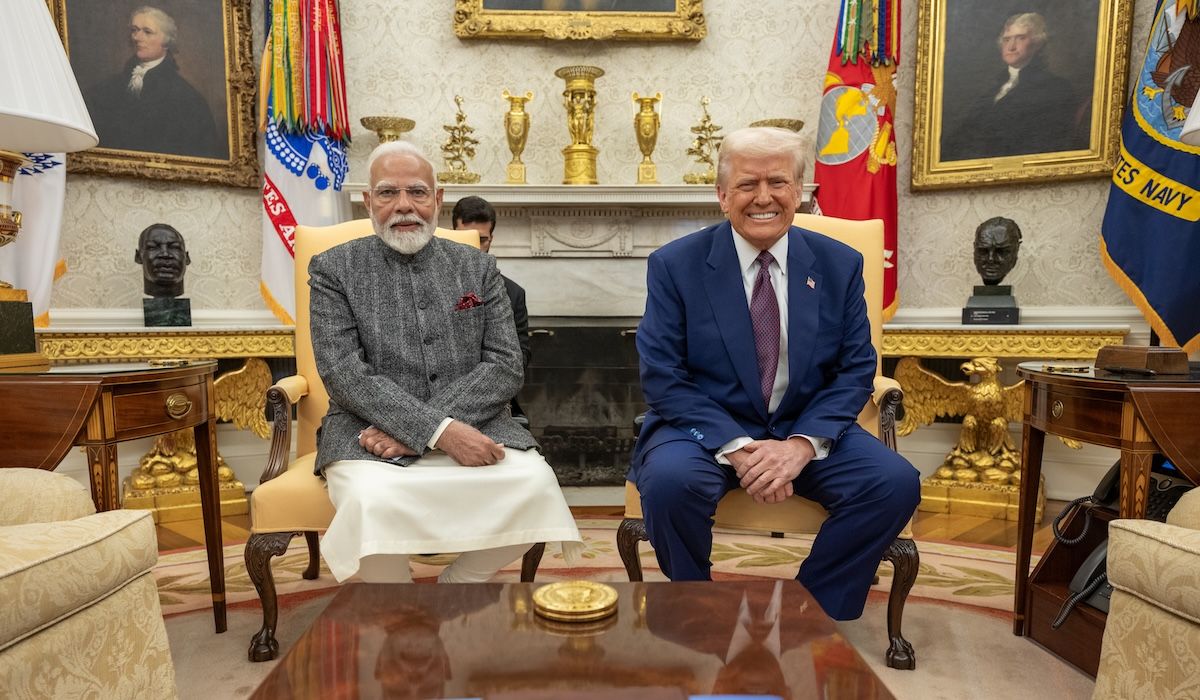Visa Program Becomes Inflection Point in US-India Geopolitical Tensions
Amber Sinha / Oct 1, 2025Amber Sinha is a contributing editor a Tech Policy Press.

President Donald J. Trump hosts Prime Minister Narendra Modi of India at the White House, Feb. 13, 2025. (Official White House Photo)
The recent Presidential Proclamation by United States President Donald Trump, which sets a $100,000 fee for H-1B visa applications, marks the latest chapter in multiple intersecting stories playing out in American domestic politics and its geopolitical turf wars with key trade and service partners and rivals. It marks a decisive shift in the tension between economic pragmatism and nativist politics in US immigration policy, explicitly framing the H-1B program as a national security threat. It signals that the Trump administration’s anti-immigrant fervor is now outweighing both market logic and the country’s longstanding geopolitical interests.
MAGA and the "good" immigrants
The first story is that of the MAGA movement against immigration and the complex place that H-1B visas have occupied in US immigration politics. The US has a long history of exclusionary, often racist immigration practices dating back to the 1798 Alien and Sedition Acts. The legal foundations of current immigration practices can be traced back to the Chinese Exclusion Act, which established the federal government's ‘plenary powers’ to exclude foreigners from entry and to expel non-citizens with minimal judicial oversight. Perhaps the most influential racist immigration law in the US was the 1924 Johnson-Reed Act. It sharply limited immigration from Eastern and Southern Europe through a national origins quota system and extended the ban on Chinese immigrants to other Asian countries.
This trend began to change only in 1965 with the Hart-Cellar Act, when skill-based migration and family reunification became the primary criteria on which long-term visas are granted. The history of immigration politics in the US since then is complex; scholar Caroline Nagel describes it as one in which “multiple contradictory impulses coexist uneasily over time.” Rather than breaking with norms, the current MAGA rhetoric against immigration taps into the country’s historical nativist tendencies.
Where Project 2025 and the second Trump administration break away from the dominant conservative view since 1965 is over the H-1B visa. Over time, skill-based immigration to address specific and defined labor shortages, and specifically the H-1B visa program, was seen as pro-business and good for the economy by Republicans. The recipients of this program, who have often also been able to get renewals and subsequently green cards, personify the ideas of “good immigrants”. They contribute to the growth of the country, are predominantly educated and skilled in fields like technology, medicine, and STEM, and contribute to the economy and taxes. This is in contrast to the “bad” immigrants who are less educated, a burden on the state, and, in the populist imagination, likely to be associated with crime. The good immigrant narrative has had more appeal across the political spectrum due to its reliance on populist economic arguments over humanitarian ones to justify immigration.
Even Trump had, till recently, sought to make an exception for H-1B visa holders in his overall rhetoric against immigration, and his former close associates, Elon Musk and Vivek Ramaswamy, had argued vehemently for it. The months leading up to Trump’s inauguration saw this debate play out openly on social media. In December, far-right political activist Laura Loomer criticized the appointment of Sriram Krishnan, an Indian-American venture capitalist, as a Senior White House Policy Advisor on Artificial Intelligence. Ramaswamy and Musk pushed back. Ramaswamy’s subsequent post, in which he blamed “American culture,” quickly saw him out of favor. Musk threatened MAGA opponents of the H-1B program that he would “go to war on this issue the likes of which you cannot possibly comprehend.”
In no time, Indian technologists in the US, and the H-1B program that facilitated their migration, were in the middle of a mini civil war amongst Trump’s loyal factions. This very public debate captured the two contrasting positions within Republican politics — the more economic view, which rewards good immigrants, taken by Ramaswamy and Musk; and the extreme anti-immigrant view taken by Loomer and Stephen Miller, the White House deputy chief of staff. At the time, Trump backed Musk. But now that they have parted ways, his position, always flexible, has changed.
The new proclamation on the H-1B program, thus, represents a clear victory for the hard right faction of the MAGA movement, prioritizing nativist politics over any other humanitarian, economic, and geopolitical considerations that previous administrations had treated as more important. It brings to the fore the inherent trouble with the idea of the “good immigrant.” In its essence, it views all immigrants as “bad” until they have proven themselves worthy and earned the right to be treated as humans.
The impact of H-1B restrictions on India
Indian nationals have occupied a disproportionate share of H-1B recipients, at 71% last year; thus, any analysis of the impact of the new proclamation needs to take into account how rapidly evolving US-India relations play into this.
The immediate press attention on the fallout following the proclamation has been on large American technology companies and how it curbs their ability to hire global talent, notably from India and China. The concerns in India are grave and relate to the primary business models of the companies that make up India’s $280 billion information technology industry. Over half of this revenue is from the US, where Indian companies follow a model of providing IT services, led by rotating staff into US companies and projects. The high monetary threshold will mean their US clients will have to be much more selective in sponsoring H-1B visa candidates. This, in turn, will render the current working model of Indian technology companies untenable, and it remains to be seen whether they can evolve to operate in this new reality.
Reuters forecasts that this may lead to an acceleration of growth in the global capability centers (GCC) of US companies. GCCs are strategic offshore or nearshore setups established by large companies and have evolved as an alternative to the outsourcing model. India currently has more than 50% of the world’s GCCs, but in this new environment, it may compete for US business with time-zone proximate locations such as Canada and Latin America. More broadly, the latest costs and restrictions on the H-1B program may reshape the global distribution of talent in the technology industry, which could have long-term implications for its structure.
Where does this leave the US-India relationship?
The second story that the proclamation and its fallout intersect with was the trajectory of US-India relations and the evolution of the broader international context. The Indian government’s official response to the H-1B developments was characteristically dour, though it warned that the move would likely have “humanitarian consequences by way of the disruption caused for families.”
But Indian policymakers should have taken note of the harsh language in the proclamation with concern. It calls the H-1B program “a national security threat,” and accused H-1B reliant companies of engaging in “visa fraud, conspiracy to launder money... and other illicit activities to encourage foreign workers to come to the United States.” The proclamation also calls out the behavior of a “software company [that] was approved for over 5,000 H-1B workers in FY 2025; around the same time, it announced a series of layoffs totaling more than 15,000 employees. American IT workers have reported they were forced to train the foreign workers who were taking their jobs and to sign nondisclosure agreements about this indignity as a condition of receiving any form of severance.” It was reported that this was a likely reference to one of the largest Indian IT companies.
In a recent piece, I argued that India and the US have grown closer over the last three decades through the expanding role of American companies in India’s digital and financial economy, and mutual strategic and geopolitical interests in countering China. Despite the rumblings about Indian immigrants from the MAGA base and unease over tariffs, there was an expectation in India that the relationship was deep enough to endure these challenges.
But it appears that the break between Indian Prime Minister Narendra Modi and Trump over who should get credit for resolving the cross-border conflict between India and Pakistan earlier this year has helped usher in a new phase in this relationship. The statement by the Indian representative at the UN General Assembly last week, rejecting Pakistani (and US) claims about how the conflict came to an end, only further cemented this break. Closer ties between the two countries might have translated into the Trump administration making different choices about the H-1B visa program. While both governments seem to be making headway towards reaching a trade deal, India may need to be prepared for further punishment from the Trump administration.
Authors
